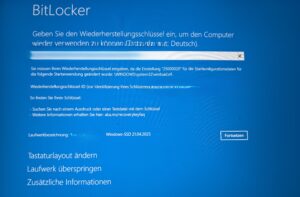Avast Free Antivirus over the years really had gotten annoying. Not only do I directly know a person where even the Premium Version led to constant annoyment because it was randomly blocking internet communications via the Windows Firewall, it also caused all kinds of disturbances with its “Smart-Scan” that occur sometimes ever couple of minutes and bring up annoying popups every time they run.
Time to remove the thing.
But be aware!
After rebooting you will be asked for your BitLocker recovery key(s). And if asked, you better have them or you better have a good and recent backup of your data:
In general it is a good idea for backup your BitLocker keys, because a TPM- or simple firmware-update of your machine could also invalidate the current TPM state and require the recovery keys. Save them, store them in a safe location.
As for Avast: It would be good if within the uninstall process, they would warn you.
